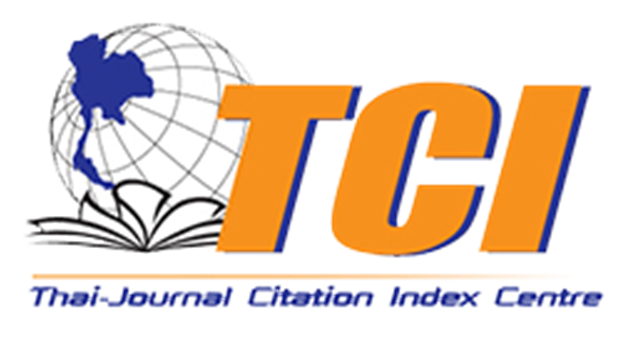Optimum Design of Reinforced Concrete Cantilever Stair Using Bisection Algorithm
การออกแบบบันไดคอนกรีตเสริมเหล็กแบบยื่นที่เหมาะสมด้วยอัลกอริทึมแบ่งครึ่งช่วง
Abstract
งานวิจัยนี้เสนอการออกแบบบันไดคอนกรีตเสริมเหล็กแบบยื่นโดยใช้วิธีอัลกอริทึมแบ่งครึ่งช่วงตาม วิธีหน่วยแรงใช้งานของวิศวกรรมสถานแห่งประเทศไทย (มาตรฐาน วสท. 011007-19) ในการออกแบบด้วยอัลกอริทึมนี้ จะมีการประเมินราคารวมของบันไดคอนกรีตเสริมเหล็กแบบยื่น โดยอิงจากราคาวัสดุก่อสร้างและค่าแรงงานในปัจจุบัน การทดสอบเปรียบเทียบระหว่างวิธีอัลกอริทึมแบ่งครึ่งช่วงกับวิธีฮิลไคลมิงอัลกอริทึมแบ่งเป็น 3 ตัวอย่าง ผลการศึกษาพบว่า ทั้งสองอัลกอริทึมสามารถค้นหาคำตอบที่เหมาะสมได้เหมือนกัน แต่ต่างกันในจำนวนรอบการทำงาน โดยวิธีอัลกอริทึมแบ่งครึ่งช่วงมีแนวโน้มการลู่เข้าสู่คำตอบที่เหมาะสมได้อย่างมีประสิทธิภาพดีกว่าวิธีฮิลไคลมิงอัลกอริทึม โดยสามารถลดจำนวนรอบการทำงานได้มากกว่า คิดเป็นร้อยละ 57.30 64.23 และ 71.63 ตามลำดับ เมื่อทดสอบซ้ำ 30 ครั้ง พบว่ารอบการทำงานเฉลี่ยของวิธีอัลกอริทึมแบ่งครึ่งช่วงเร็วกว่าวิธีฮิลไคลมิงอัลกอริทึม ร้อยละ 28.56 42.94 และ 49.41 ตามลำดับ ดังนั้นวิธีอัลกอริทึมแบ่งครึ่งช่วงจึงสามารถนำมาใช้ในการออกแบบบันไดคอนกรีตเสริมเหล็กแบบยื่นได้อย่างมีประสิทธิภาพ
This study proposes the design of a reinforced concrete cantilever stair using the Bisection Algorithm according to the Working Stress Design Method of the Engineering Institute of Thailand (EIT Standard 011007-19). In the design using this algorithm, the total cost of the cantilever stair will be estimated based on current construction material and labor prices. The experiment compared the performance of the Bisection Algorithm with the Hill Climbing Algorithm across three samples. The results indicated that both algorithms can find feasible solutions, but they differed in the number of iterations required. The Bisection Algorithm showed higher efficiency in converging to an optimal solution, reducing the number of iterations by 57.30, 64.23, and 71.63%, respectively, compared to the Hill Climbing Algorithm. In 30 repeated tests, the Bisection Algorithm was found to perform faster, reducing the average number of iterations by 28.56, 42.94, and 49.41%, respectively. Therefore, the Bisection Algorithm can be effectively applied in the design of reinforced concrete cantilever staircase.
Keywords
[1] A. Kaveh and S. Talatahari, Optimum design of skeletal structures using imperialist competitive algorithm, Computer and Structures, 2010, 88(21–22), 1220–1229.
[2] M.P. Saka, O. Hasançebi, and Z.W. Geem, Metaheuristics in structural optimization and discussions on harmony search algorithm, Swarm and Evolutionary Computation, 2016, 28, 88–97.
[3] V. Yepes, J.V. Martí, and T. García-Segura, Cost and CO2 emission optimization of precast–prestressed concrete U-beam road bridges by a hybrid glowworm swarm algorithm, Automation in Construction, 2015, 49(Part A), 123–134.
[4] V. Govindaraj and J.V. Ramasamy, Optimum detailed design of reinforced concrete continuous beams using Genetic Algorithms, Computer and Structures, 2005, 84(1–2), 34–48.
[5] J. Cheng, Optimum design of steel truss arch bridges using a hybrid genetic algorithm, Journal of Constructional Steel Research, 2010, 66(8–9), 1011–1017.
[6] S. Patchotichai, N. Jitrapinat, and A. Lamom, Optimum design of axial loaded reinforced concrete column using bisection algorithm, Ladkrabang Engineering Journal, 2011, 28(3). (in Thai)
[7] A. Tapown, A. Lamom, and R. Cheerarot, Optimal design of biaxial reinforced concrete rectangular column by heuristic algorithm, Thesis, Mahasarakham University, Thailand. 2012.
[8] M.M. Francisca, S. Tatiana, J.V. Jose, and Y. Victor, Optimization of buttressed earth-retaining walls using hybrid harmony search algorithms, Engineering Structures, 2017, 134, 205–216.
[9] A. Akin and M. P. Saka, Harmony search algorithm bases optimum detailed design of reinforced concrete plan frames subject to ACI 318–05 provisions, Computer and Structures, 2015, 147, 79–95.
[10] S. Chomchuen and A. Lamom, Optimum design of prestressed concrete plank girder using hill climbing algorithm, UBU Engineering Journal, 2021, 14(14), 129–140. (in Thai)
[11] A. Tapown and R. Cheerarot, Optimum design of reinforced concrete foundations by fruit fly optimization algorithm, The Journal of King Mongkut's University of Technology North Bangkok, 2021, 31(1), 16–24. (in Thai)
[12] M. Azizi, S. Talatahari, M. Basiri, and M.B. Shishehgarkhaneh, Optimal design of low- and high-rise building structures by Tribe-Harmony Search algorithm, Engineering Structures, 2022, 3, 100067.
[13] G.-C. Cui, T. Liang, G.-F. Han, and J. Ji, An optimization and adjustment method of pile orientation for a pile-supported wharf based on a genetic algorithm, Journal of Marine Engineering, 2022, 2022, 1–13.
[14] EIT Standard 011007–19, Building Code Requirements for Reinforced Concrete Working Stress Design Method, The Engineering Institute of Thailand Under H.M. The King’s Patronage, Bangkok, Thailand. 2019
[15] C. Jarujinda, Reinforced concrete design, Bunloet Printing House, Bangkok, Thailand. 1999.
[16] V. Chorwichian, Reinforced concrete design (working stress design: WSD), P.S. Commercial Ltd, Bangkok, Thailand. 1999.
[17] Standard Building Construction Price Calculation Criteria, Announcement of the Committee on Standard Prices and Contractor Registration on Criteria and Methods for Determining Standard Construction Prices, 19 October 2017, Thailand, 2017.
[18] http://www.indexpr.moc.go.th/PRICEPRESENT /table_month_regionCsi.asp (Accessed on 10 August 2022).
[19] Guidelines, Practices, and Details for Quantity Takeoff and Calculation of Standard Construction Prices, Announcement on Criteria and Methods for Standard Construction Prices, 19 October 2017, Thailand. 2017.
[20] J. Pearl, Heuristic: Intelligent search strategies for computer problem solving, Reding, Addison-Wesley Publishing Co., MA, USA, 1984.
[21] P. Dachaompai and N. Vannasopark, Numerical methods in engineering, Chulalongkorn University Printing House, Bangkok, Thailand. 2017.
DOI: 10.14416/j.ind.tech.2025.04.006
Refbacks
- There are currently no refbacks.






